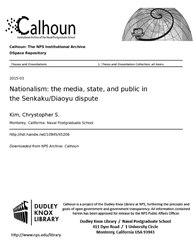File:Nationalism- the media, state, and public in the Senkaku-Diaoyu dispute (IA nationalismmedia1094545206).pdf

Original file (1,275 × 1,650 pixels, file size: 1.46 MB, MIME type: application/pdf, 122 pages)
Captions
Captions
Summary
[edit]| Nationalism: the media, state, and public in the Senkaku/Diaoyu dispute
( |
||
|---|---|---|
| Author |
Kim, Chrystopher S. |
|
| Title |
Nationalism: the media, state, and public in the Senkaku/Diaoyu dispute |
|
| Publisher |
Monterey, California: Naval Postgraduate School |
|
| Description |
Since diplomatic normalization in 1972, Sino-Japan relations have hit a new low due to escalating military and diplomatic confrontation around the islands in the East China Sea, known as the Senkaku in Japan and the Diaoyu in China. Through a comparative media analysis of the dispute, this thesis considers the extent to which China and Japan are instrumentally influencing nationalist rhetoric in the media in order to advance state interests. Media analysis indicates a pattern of rising nationalist rhetoric in both Japan and China over the 23-year period from 1990 to 2013. Contextual analysis of historical events also suggests that both China and Japan have used the dispute instrumentally to bolster domestic support while attempting to manage nationalist rhetoric in order to prevent negative international consequences. However, due to popular nationalism transforming journalistic and political consensus, Tokyo’s influence over the media in Japan declined steeply after 2010. In China, the state maintains strict oversight over the media and public mobilizations, but Beijing may also be slowly losing its control over popular nationalism. In sum, popular nationalism may be growing beyond state control, limiting political options to improve bilateral relations for both Chinese and Japanese leaders. Subjects: nationalism; Senkaku; Diaoyu; media; Sino-Japanese relations; state control of media; public influence in media |
|
| Language | English | |
| Publication date | March 2015 | |
| Current location |
IA Collections: navalpostgraduateschoollibrary; fedlink |
|
| Accession number |
nationalismmedia1094545206 |
|
| Source | ||
| Permission (Reusing this file) |
This publication is a work of the U.S. Government as defined in Title 17, United States Code, Section 101. Copyright protection is not available for this work in the United States. | |
Licensing
[edit]| Public domainPublic domainfalsefalse |
This work is in the public domain in the United States because it is a work prepared by an officer or employee of the United States Government as part of that person’s official duties under the terms of Title 17, Chapter 1, Section 105 of the US Code.
Note: This only applies to original works of the Federal Government and not to the work of any individual U.S. state, territory, commonwealth, county, municipality, or any other subdivision. This template also does not apply to postage stamp designs published by the United States Postal Service since 1978. (See § 313.6(C)(1) of Compendium of U.S. Copyright Office Practices). It also does not apply to certain US coins; see The US Mint Terms of Use.
|
 | |
| This file has been identified as being free of known restrictions under copyright law, including all related and neighboring rights. | ||
https://creativecommons.org/publicdomain/mark/1.0/PDMCreative Commons Public Domain Mark 1.0falsefalse
File history
Click on a date/time to view the file as it appeared at that time.
| Date/Time | Thumbnail | Dimensions | User | Comment | |
|---|---|---|---|---|---|
| current | 04:16, 23 July 2020 |  | 1,275 × 1,650, 122 pages (1.46 MB) | Fæ (talk | contribs) | FEDLINK - United States Federal Collection nationalismmedia1094545206 (User talk:Fæ/IA books#Fork8) (batch 1993-2020 #22578) |
You cannot overwrite this file.
File usage on Commons
The following page uses this file:
Metadata
This file contains additional information such as Exif metadata which may have been added by the digital camera, scanner, or software program used to create or digitize it. If the file has been modified from its original state, some details such as the timestamp may not fully reflect those of the original file. The timestamp is only as accurate as the clock in the camera, and it may be completely wrong.
| Short title | Nationalism: the media, state, and public in the Senkaku/Diaoyu dispute |
|---|---|
| Author | Kim, Chrystopher S. |
| Software used | Kim, Chrystopher S. |
| Conversion program | Adobe PDF Library 11.0 |
| Encrypted | no |
| Page size |
|
| Version of PDF format | 1.4 |

